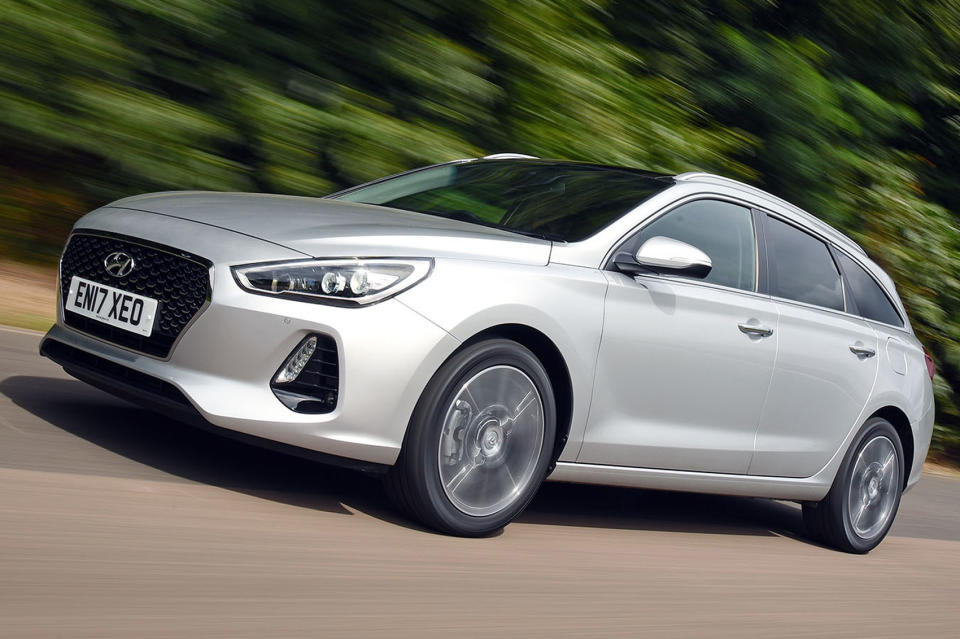Hyundai i30

As recent industry feats go, Hyundai Motor Company’s incursion onto the European continent must rank among the most impressive. A decade ago, when the original Hyundai i30 was launched, the Korean manufacturer was little more than a sideshow in volume terms.
In 2015, it registered 470,130 vehicles here – which was nearly 11 percent more than it managed the year before.
Its success story owes something to good fortune (the scrappage scheme of 2008 benefited no other firm quite so vigorously) but mostly it has been achieved by adroitly supplying buyers with what they want: build quality, equipment, keen pricing, practicality, reliability and a long, unlimited warranty to underpin it all.
Moreover, and no less important, there is Hyundai’s rapacious appetite for refreshing its line-up.
This latest generation of the i30 is the third, and although it might not quite qualify as ‘all-new’ (the platform has been overhauled materially rather than switched out), the new model’s introduction is significantly more impactful than many will believe.
Not least among its alterations is a new look – delivered by Peter Schreyer, the Hyundai-Kia design demigod – that will inform (another) new generation of product. There are new engines, too, most notably the 1.4-litre T-GDi fitted to our test car.
Also bolted on is the Tourer configuration, which, the firm believes, will achieve close to a 20 percent share of total i30 sales in the UK.
The reason for that is simple: the estate’s starting price is £1500 lower than its predecessor’s, and there’s now only £500 between it and the hatch across the rest of the range.
And if Hyundai’s meteoric rise proves anything, it’s that customers respond very kindly to evidence of good sense.
Now the car just needs to prove at least as good as a Ford Focus, Volkswagen Golf, Vauxhall Astra, Mazda 3, Honda Civic, Peugeot 308, Renault Mégane and Seat Leon. Acid test time.
Hyundai i30 design & styling
Schreyer’s influence over Hyundai’s design language has been well earned.
The foundation of the success of sister brand Kia is partly built on the sophisticated, clean-cut look that the German design chief is justly famous for delivering.
However, the i30 finds him in a relatively conservative mood. Despite the firm touting design as the “number one buying reason” among European customers, the car – in both Tourer and hatchback format – is a thoroughly conventional-looking C-segment prospect.
Its most notable feature is the new ‘cascading grille’, a tapering affair apparently inspired by the flow of molten steel and destined to become a hallmark across the line-up, but even this is a rather conformist affair and makes the i30 no more likeable or distinctive than a regiment of similarly modern-looking mainstream rivals.
Arguably, of course, there is no overriding need to stand out from the crowd (overly quirky family hatchbacks have a history of falling flat with buyers) and most repeat customers will likely settle for the idea that the model is marginally more appealing than the car it replaces.
Underneath, it is very much like its predecessor. Although marginally larger, the i30 essentially has the same architecture – albeit in a notably lightened, stiffened format.
The car’s gain, particularly as far as torsional rigidity is concerned, is a direct consequence of a doubling of the proportion of high-strength steel used in its construction. The lower-riding chassis – still a conglomerate of front MacPherson struts and rear multi-link – has inevitably been retuned for the enhanced setting, with Hyundai claiming a 10 percent improvement in steering response.
The new engine line-up is considerably more sturdy, too. The previous generation, certainly by the end of its lifecycle, was handicapped by a number of powerplants well past their sell-by date. Only the 109bhp 1.6-litre CRDi diesel four-pot makes the transition and, in line with the rest of the segment’s revised attitude to oil-burners, expect that unit to be soft-pedalled in retail terms.
Instead, the real choice is between the three-cylinder 118bhp 1.0-litre T-GDi motor, which has made its debut elsewhere, and the new four-cylinder 138bhp 1.4-litre T-GDi engine of our test car. This 1.4 is important because it finally provides the i30 with a forced-induction, petrol-burning engine that promises a very European compromise of power and parsimoniousness.
Better still, despite the additional single-scroll turbocharger, Hyundai insists that the four-pot is 14kg lighter than the venerable naturally aspirated Gamma unit it replaces.
We drove it with the standard six-speed manual gearbox, although a seven-speed dual-clutch transmission is available as an option.
]]>

 Yahoo Autos
Yahoo Autos 